The most unpleasant symptoms, such as itching and rash, can cause subcutaneous parasites in people of all ages. Due to complications, any invasion will bring many health problems. Worm species that have an incubation period of several months are particularly dangerous.
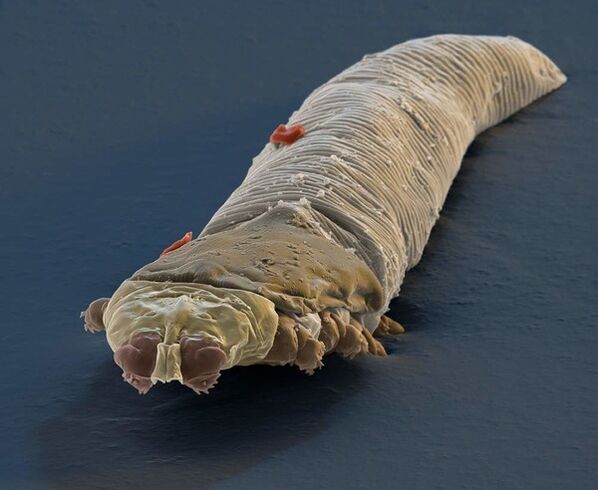
Types of parasites living under the skin
Subcutaneous worms can enter the human body: tactile contact with an infected person; blood-sucking insects that carry animal parasite larvae.
The main feature of this invasion is that it is difficult to identify the pathology, because the initial infection can be disguised as other physical diseases.
After parasitizing under the thickness of the skin, over time, the parasite can move to any internal organs and cause its dysfunction. Worms feed on blood and use it to hatch larvae.
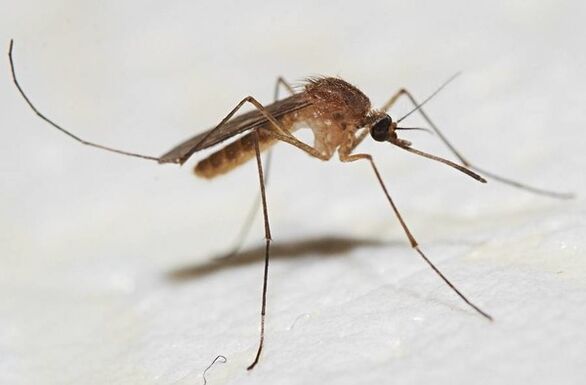
The main signs of the presence of such parasites in the body are severe weakness, decreased performance, and constant desire to scratch the skin. When these signs appear, it is recommended to see a specialist: therapist, dermatologist, allergy specialist, infectious disease specialist. The joint work of doctors and the diagnostic methods they use at work helps to recognize the presence of subcutaneous infiltration in the body in a timely manner.
In the diagnostic method, feces, blood, scalp and epidermal scraping must be studied.
The most common infections of subcutaneous worms occur in countries with very warm climates-Central Asia, Africa, and South America. Therefore, you need to pay special attention to your health when returning from travel on all continents.
important! It is strictly forbidden to treat yourself with medical and folk remedies-this will aggravate the condition and poison the body. Be sure not to delay treatment, and strictly follow the prescribed medication and treatment course.
There are many types of worms living in the skin. The invasive species listed below are the main invasive species.
Filariasis
The subcutaneous worms of this species are represented by filamentous nematodes, which are common in tropical countries. This parasite can live in the skin continuously for several years, after adapting itself, it will migrate in the body to find another habitat.
The first signs of disease are rashes in the form of hives and spots, accompanied by itching. Then add temperature.
Serious signs of filariasis include eczema, ulcers and warts, subcutaneous nodules, severe headaches, lethargy, increased subcutaneous nodules and fever.
Parasites can usually be found in an ophthalmologist’s examination because he likes to live in the mucous membrane of the eye.
important! If you do not seek medical attention in time, filariasis can cause eye diseases and result in complete loss of vision.
Schistosomiasis
The parasites of this species live in warm freshwater rivers and lakes in countries with hot climates. Infection may occur when bathing or drinking raw water.
Parasites affect the skin and urinary system at the same time. Toxic substances entering the blood can seriously poison the body, which can cause various obstacles to the work of many organs and systems.

The signs of parasitic infection are: rash and skin flushing in the form of dermatitis, unbearable itching, night sweats, enlarged liver, renal system dysfunction, and sudden rise in body temperature.
Schistosomiasis occurs with damage to the genitourinary system, which can block the access to the bladder.
important! In order not to be infected by this worm, you cannot swim in tropical stagnant waters, nor can you drink raw water from unfamiliar natural sources.
Dracunculiasis
This disease is caused by the rishta-roundworm-parasite, which can reach up to 80 cm in length. Worm infections are home to tropical climates and Central Asian countries, possibly due to the use of raw water or contact with cats and dogs that are carriers of worms.
The incubation period from infection with parasite eggs to migration in the body is 1. 5 months. Parasites develop and grow throughout the year.
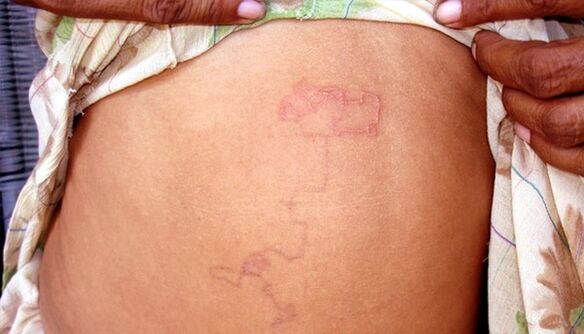
Dracunculiasis mainly affects the skin of the lower limbs. The parasite can twist and unfold, forming a long bump on the skin, followed by a few centimeters of bubbles. As soon as the bubbles come into contact with water, they burst and release the larvae, causing severe internal itching symptoms.
important! Without treatment and fighting against such parasites, the person begins to develop sepsis, gangrenous inflammation, or joint immobility.
scabies
The mite type that is 0. 4 mm long is the main culprit for scabies. If the patient's immunity is severely reduced, the parasite can be infected by touching the patient's body or his things. Infection occurs when hygiene rules are not followed.
The small parasites that enter the skin first enter the epidermis, then the deep layers, and can infect the whole body with toxins. The parasites gnaw at the channels through which they lay their eggs.
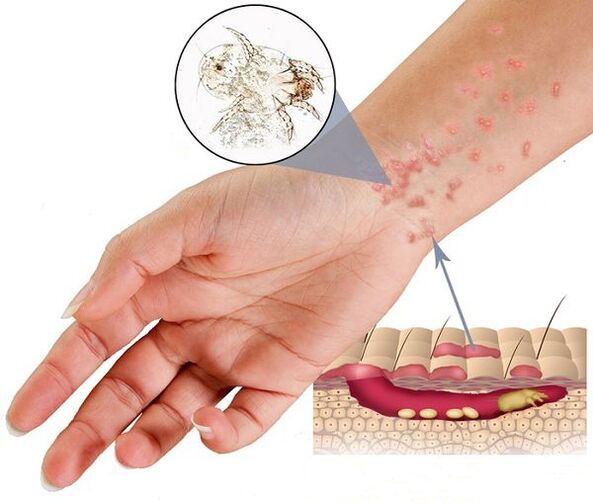
The pathological clinical symptoms appear in the form of red skin rashes, small blisters, and peeling skin: hands, thighs, elbows, knees, and hair. If you use an iodine solution to treat the rash, then you can see ticks.
Due to the active development and reproduction of parasites, a person will be tortured by unbearable itching, intensified at night, craving to scratch the skin, and after exposure to water.
Complications of scabies include furunculosis, eczema, dermatitis and skin blisters.
important! In order not to get scabies, you need to follow hygiene rules and avoid contact with people who are infected with scabies.
Demodex
This disease caused by tiny mites is seasonal, and more often occurs in autumn. The formation of excess fat on the skin in summer and the negative effects of ultraviolet rays can destroy local immunity, thereby promoting the spread of this mite.
Parasites can be infected through tactile contact with the patient and the use of his personal belongings and care products.
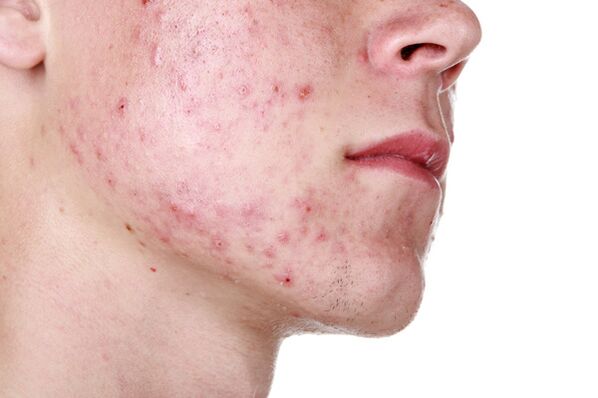
According to clinical symptoms, the pathology is very similar to acne, and acne occupies more and more areas. Pink and red papules are widely distributed on the face and back, and will leave rough scars after healing. A person may experience eyelid inflammation, dilated blood vessels, and peeling eyebrows.
important! Over the years, demodicosis has continued to develop. To accurately diagnose a person, remove the scraper from the skin. Treatment may take up to 3 months.
Heartworm disease
Invasion is considered a dangerous parasitic disease, caused by heartworm, which can reach 30 cm in adulthood. This parasite affects the subcutaneous area and eye tissues and can cause complete loss of vision.
The incubation period for the development of heartworm disease is several years. A person may be bitten and infected by mosquitoes, which carry parasite eggs from sick dogs and cats.
Seals grow in the skin, accompanied by soreness, unbearable itching and congestion. Seals can grow to the size of an ordinary egg, in which coiled worms live.
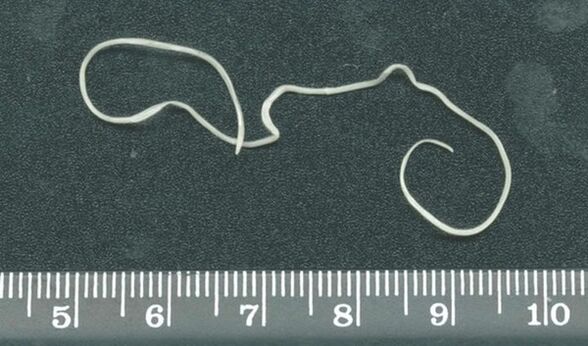
Basically, parasites live in the skin, but sometimes they crawl into the eyes, causing visual impairment and vision loss.
In order not to be infected by this worm, you need to fight against mosquitoes through various possible methods and use insect repellent in your daily life.
How to remove subcutaneous parasites?
The fight against subcutaneous worms is based on the use of surface and drug methods and surgical procedures.
The anti-parasitic treatment for each worm can be presented in the form of a table:
| Types of helminthiasis | Application method |
|---|---|
| Filariasis | An anthelmintic used to treat filariasis. Severe cases can be treated surgically. |
| Schistosomiasis | Use antimony and surgical techniques. At the same time, the affected organs need to be repaired. |
| Dracunculiasis | Surgery to remove worms. |
| scabies | Local remedies: salicylic acid ointment and sulfuric acid soap; water soap suspension; hydrochloric acid solution for 1 week. Immunization preparations. Thoroughly disinfect the patient’s clothing and household items. Sometimes antibiotics are used. |
| Demodex | Use external agents: camphor alcohol, and thorough beauty care (cleansing, mask, peeling), use of hyaluronic acid, alginate. Use immunostimulants, vitamin complexes, and anti-inflammatory drugs. The accompanying digestive tract and metabolic diseases must be treated. A healthy diet and physical therapy are essential. |
| Heartworm disease | Surgical treatment. It may be necessary to remove the eyeball. |
In most cases, you can remove subcutaneous worms with surgery and intensive chemotherapy.
Surface treatment
The surface action method is used to combat worms that live in the epidermis (for example, scabies and demodicosis).
Rub the topical antiparasitic medicine on the skin with scabies. These drugs are rubbed all over the body at night. The course lasts 2 weeks. It is recommended that people who have been in contact with an infected person perform the same procedure.
For demodicosis, use suspensions, ointments, solutions, gels, scrubs, cryotherapy, which can reduce sebum secretion, deprive food and reduce the negative effects of parasites.
For other types of worms, external manifestations can be removed with the help of ointments containing steroids and antibiotics.
All ointments specially selected by doctors can relieve inflammation, deprive parasites of motor activity and kill them.
Local operation must be moderate to avoid damage to the skin, so as not to disturb the acid-base balance, and rule out the pathological attachment of pathogenic microorganisms.
important! When starting a course of treatment at high temperatures, it is necessary to wash clothes and heat the pillow in bright sunlight.
drug
For each type of worm, apply its own medicine, and the doctor will prescribe it according to the stage of the disease.
Some drugs can completely kill the parasites, while others make them unable to move and prevent their reproduction.
When the worm dies, a person may show signs of poisoning-headache, nausea, and vomiting, so the medicine is carefully selected. Ingestion of intestinal adsorbent is allowed.
Major diseases must be treated with pathology from other organs. Use symptomatic treatment.
Surgical methods
The intervention of the surgeon is necessary to remove the parasite through the incision.
The operation was performed as usual under local anesthesia. The surgeon needs to be a master of art and his craftsman, so that when removing the worm, it can be pulled out completely, rather than divided into several parts.
Rehabilitation methods after surgery include treatment with antibiotics, analgesics, anti-inflammatory drugs, and antiparasitic drugs.

Prevent helminthiasis infection
Be careful, it is possible to prevent subcutaneous worms from entering the body.
necessary:
- Receive annual physical examination;
- Consult a doctor about various diseases;
- Wash hands thoroughly after going to public places and touching strangers and stray animals;
- Boil raw water and do not drink water from natural sources;
- Do not swim in stagnant water bodies, especially in hot countries;
- Use insect repellents and protective devices against blood-sucking insects;
- Carry out the daily and general cleaning of the house and maintain order.
When traveling to a pandemic, you need to follow safety measures and make sure you know all the information about how to protect yourself during the journey.
It is necessary to improve immunity through a healthy lifestyle, a good diet, hardening and taking vitamin complexes several times a year.
Fighting against subcutaneous parasites requires patience and effort. If all the doctor's prescriptions are followed, the person will fully recover.



























